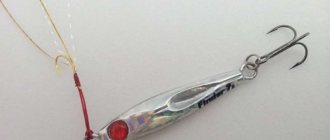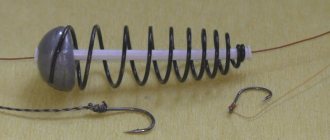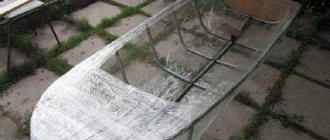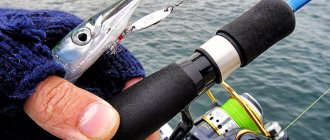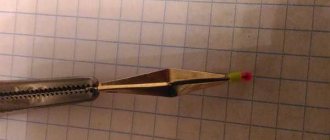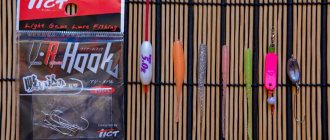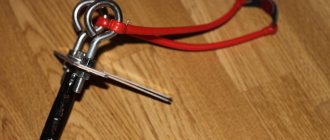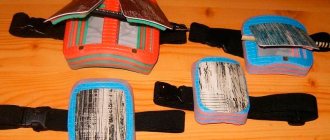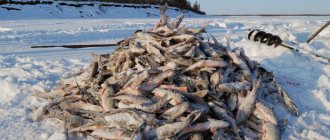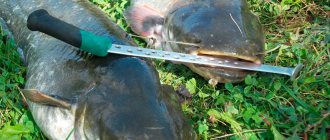Each fisherman decides for himself which eye-catching parts for sea fishing are most appropriate to buy.
- Peculiarities
- Kinds
- How to choose?
- Application
Fishing at sea has a lot of differences from fishing in smaller bodies of water. First of all, the fisherman should use more noticeable and massive baits. Only if this condition is met does it make sense to expect a rich catch. For sea fishing, a separate type of spinner is best suited - jigs. Let's talk about them.
In the classical sense, a jig is a heavy, narrow-bodied spoon, the ratio of length to width is about 6:1. Many models have a round, hexagonal, rectangular or square section. The weight of the bait is decent, allowing you to quickly deepen it and keep it in the fishing zone, regardless of the strength of the current.
Jigs for sea fishing
For sea or lake fishing, various tackles and baits are used. One of them is jigs. Essentially, these are weighted spoons, which are more often used for sea fishing for catfish, flounder, cod, halibut, etc. Fishing is carried out from different types of vessels: boats, cutters, yachts or ships.
What is a jig and how to use it?
A traditional jig is an elongated, weighted metal block to which hooks are soldered. It is intended for deep-sea fishing and is more often used on the seas, although there are also species that are used for catching freshwater fish.
The jig is designed for deep-sea fishing and is more often used on the seas
There are two main techniques:
- fishing without casting - the process is carried out by lowering the tackle to the bottom over the side of the vessel;
- fishing with casting over long distances using different fishing techniques.
Fishing without casting
You need to purchase a jig, rod and reel suitable for this type of fishing. The rod must be strong, from 1.9 to 2.4 meters long and with special rollers. A multiplicative type inertial coil is also used.
This technique is mainly used at depths of 100–400 meters and is popular in Norway and Denmark.
When fishing, other factors are taken into account, such as wind strength and current speed. The technique itself consists of twitching the rod up and down. This should attract fish. For greater effect, they hook bait, which can be a sea worm or a small fish.
Casting fish
For this technique, fishing spots with shallower depths are selected. You can use elongated, heavy, round or flat spoons, with one or two treble hooks.
The hook, which is attached to the upper ring, can be baited with additional bait, which increases the chances of getting a catch.
Using two tees has its drawbacks. Hooks can get caught on an uneven bottom, and, accordingly, the risk of breaking the tackle doubles.
Additional bait can create a bite effect and provoke the fisherman into useless hooks.
The weight of jigs used for casting fishing is less than in the vertical deep-sea fishing technique. The ideal option is considered to be gear weighing 75–85 grams.
The fisherman makes a cast, and the line weakens when the spoon hits the water. After this, in order to feel the bait, the fishing line is pulled and retrieving is carried out using various methods.
How to make a jig with your own hands
Heavy spoons for sea fishing, intended for the use of the first technique, are quite expensive, and very often such a purchase is not justified. If you do it yourself, you won’t have to regret the money spent.
Metal tube jig
Metal tube jig
To make gear, you can use a piece of stainless steel or copper tube or a piece of metal rod.
In order to make a jig from a pipe, you will need the following:
- hacksaw for metal;
- drill and metal drill bit;
- lead (you can take an old battery);
- gas-burner;
- old tin can;
- fine-grained sandpaper;
- foil.
We decide on the length of the future gear and designate places for trimming. Use a hacksaw to cut off the edges at an angle of 45 degrees.
We disassemble the old battery and take out the lead plates from it, which we place in a tin can and heat with a gas burner.
You should take care of your own safety measures and attach some kind of handle to the tin can and handle lead carefully so as not to get burned.
When the lead turns into a liquid state, fill the metal tube with it. After the metal has hardened, take a drill and a metal drill bit and make two holes along the edges of the workpiece.
We insert the rings, after which we attach a tee to one of them. You need to make a notch in the middle of the jig so that the lead does not crawl out of the tube in cold water.
To do this, use the back of the hammer to make one blow to form a dent.
To make the jig more shiny, you can try polishing the surface of the pipe with sandpaper. If this does not give any effect, cover it with foil.
If a metal rod is used as a workpiece, all actions should be performed in the same way, but without using lead.
Cutlery jigs
Cutlery jig
DIY jigs for sea fishing can be made from cutlery of suitable shape and size.
After searching a little in the kitchen drawers, you can find some kind of knife, spoon or fork with a smooth handle. Such devices make good spinners for casting fish.
Having taken a suitable workpiece, we cut it with a hacksaw for metal. Remove uneven edges with a file and then polish with sandpaper. We drill holes with a drill, attach a hook and fishing line. The tackle is ready.
Jig from tweezers
Jig from tweezers
Oddly enough, this device can also be suitable for making spinners. Any electrical or radio repairman has it, and can also be lying around in the closet of any good owner.
The manufacturing process is practically no different from the previous one. We take tweezers and cut out a piece of the required length from one of its halves. We sand the sharp edges with a file and smooth the surface with sandpaper. Drill holes and attach hook and line.
As you can see, making tackle with the necessary tools and materials is quite easy. This requires minimal investment of money and time, which has an undeniable advantage compared to purchasing factory products. At the same time, the quality of homemade jigs is almost as good as those purchased in a store.
by HyperComments
Source: https://plotka.ru/pilkeryi-dlya-morskoy-ryibalki/
Home production of catchable jigs
Having produced several dozen good punds before the fishing season, you can be sure that the upcoming cod hunt will not cause much financial damage to its participant. Moreover, no matter how diverse the range of marine spinners for vertical and jigging is, the most popular were and remain tubular samples with lead balancing. They are also the most convenient for making at home. Material costs for equipping such a home production are extremely small: • Equipment. This is, first of all, an angle grinder, a miniature machine (in everyday slang - “grinder”) with a set of cutting and cleaning discs. Household sharpening machine with grinding and polishing wheels. A small screwdriver with a set of bits and drills. • Equipment and tools. Bench vice with jaws up to 125 mm. Gas canister with burner for melting lead or babbitt. Mobile injection molds for casting replicas of spinners. Foundry ladle with wood-lined handle. Set of files, hammer and core. • Materials. An assortment of any tubes from a wide variety of materials. They can be made of stainless steel, steel with a decorative or anti-corrosion coating, copper, brass or aluminum alloy AMG-6. Lead from old batteries or balancing weights from a tire shop. Babbitt from old plain bearings. Alabaster or gypsum for molding products in foundry molds. Important! All of the listed components of home production are not unique. Moreover, almost all home craftsmen have them. All DIYers, without exception, can make a collapsible casting mold from chipboard or multilayer plywood. The source material for the punds is completely waste - old baby strollers, disrepaired faucets from kitchens and bathrooms.
DIY jig for sea fishing
Their catchability was also in demand when fishing in reservoirs and rivers within the country.
The best examples of jigs for cod turned out to be no less popular among fans of fishing for pike perch, asp, pike and perch, both plumb and when jigging. Their size and shape have changed somewhat, but the equipment remains the same.
But the high cost of such spinners is increasingly forcing local fishermen to make jigs with their own hands.
First of all, it should be noted that the best jigs for sea fishing are heavy spoons for vertical lures. They can be classified according to several characteristic features:
- First of all, by weight. Based on this indicator, jigs are selected depending on the fishing conditions. Depending on the speed of the current, the depth of the bait and the wind speed, it can reach up to 700 and even 1000 g.
- According to its design features. They can be round, tubular, polyhedral and flat. Traditionally, homemade jigs for cod have an aspect ratio of 6:1. Moreover, their thickness correlates with width as 1:2 and, in some cases, as 1:1.
- According to the material of manufacture. These can be stainless or chrome-plated tubes filled with lead. Often there are samples made from profiled steel rods. When making homemade jigs for cod fishing, brass, cupronickel, copper and stainless steel are often used, with lead, sand and tungsten used to balance them.
Important! The cost of sea spinners of this type sometimes reaches up to 25 € per piece, and their life expectancy is no more than two or three hours. That is why the ability to make jigs for sea fishing with your own hands is not only tactical, but also purely economic.
Technical details of making jigs for sea fishing
According to most well-known sea fishing experts, the most catchy ones, in terms of design features, are triangular-shaped punds and flat samples with a wide end.
In addition, many cod hunting enthusiasts recommend equipping them with various rattles and glowing balls.
It is believed that reflective and light-accumulating stickers are good at activating fish bite in any conditions.
All these nuances are actively used by vertical lure experts when making saltwater jigs with their own hands.
A simple tool, affordable and sometimes waste material, and skillful hands leave no doubt that homemade jigs for cod are no worse than branded products in their catchability.
Only one of the popular companies produces various jigs over 40 tons. per year, without any problems with their implementation.
Home production of catchable jigs
Having produced several dozen good punds before the fishing season, you can be sure that the upcoming cod hunt will not cause much financial damage to its participant.
Moreover, no matter how diverse the range of marine spinners for vertical and jigging is, the most popular were and remain tubular samples with lead balancing.
They are also the most convenient for making at home.
The material costs for equipping such a home production are extremely small:
- Equipment. This is, first of all, an angle grinder, a miniature machine (in everyday slang - “grinder”) with a set of cutting and cleaning discs. Household sharpening machine with grinding and polishing wheels. A small screwdriver with a set of bits and drills.
- Devices and tools. Bench vice with jaws up to 125 mm. Gas canister with a burner for melting lead or babbitt. Mobile injection molds for casting replicas of spinners. Foundry ladle with wood-lined handle. Set of files, hammer and core.
- Materials. An assortment of any tubes from a wide variety of materials. They can be made of stainless steel, steel with a decorative or anti-corrosion coating, copper, brass or aluminum alloy AMG-6. Lead from old batteries or balancing weights from a tire shop. Babbitt from old plain bearings. Alabaster or gypsum for molding products in foundry molds.
Important! All of the listed components of home production are not unique. Moreover, almost all home craftsmen have them. All DIYers, without exception, can make a collapsible casting mold from chipboard or multilayer plywood. The source material for the punds is completely waste - old baby strollers, disrepaired faucets from kitchens and bathrooms.
Technology for making pipe jigs
This is one of the most popular and easiest to manufacture spinner models. The tube, beveled on both sides and the equipment attached to it, leaves no secrets for those who would like to know how to make a jig with their own hands. Some difficulties may arise when it is necessary to make a spinner with a weight differentiated by length or a rattle inside.
Source: https://ogorod.life/rybalka/pilker-dlya-morskoj-rybalki-svoimi-rukami.html
Technical details of making jigs for sea fishing
According to most well-known sea fishing experts, the most catchy ones, in terms of design features, are triangular-shaped punds and flat samples with a wide end. In addition, many cod hunting enthusiasts recommend equipping them with various rattles and glowing balls. It is believed that reflective and light-accumulating stickers are good at activating fish bite in any conditions.
All these nuances are actively used by vertical lure experts when making saltwater jigs with their own hands. A simple tool, affordable and sometimes waste material, and skillful hands leave no doubt that homemade jigs for cod are no worse than branded products in their catchability. Only one of the popular companies produces various jigs over 40 tons. per year, without any problems with their implementation.
Home production of catchable jigs
Having produced several dozen good punds before the fishing season, you can be sure that the upcoming cod hunt will not cause much financial damage to its participant. Moreover, no matter how diverse the range of marine spinners for vertical and jigging is, the most popular were and remain tubular samples with lead balancing. They are also the most convenient for making at home.
The material costs for equipping such a home production are extremely small:
- Equipment. This is, first of all, an angle grinder, a miniature machine (in everyday slang - “grinder”) with a set of cutting and cleaning discs. Household sharpening machine with grinding and polishing wheels. A small screwdriver with a set of bits and drills.
- Devices and tools. Bench vice with jaws up to 125 mm. Gas canister with a burner for melting lead or babbitt. Mobile injection molds for casting replicas of spinners. Foundry ladle with wood-lined handle. Set of files, hammer and core.
- Materials. An assortment of any tubes from a wide variety of materials. They can be made of stainless steel, steel with a decorative or anti-corrosion coating, copper, brass or aluminum alloy AMG-6. Lead from old batteries or balancing weights from a tire shop. Babbitt from old plain bearings. Alabaster or gypsum for molding products in foundry molds.
Important! All of the listed components of home production are not unique. Moreover, almost all home craftsmen have them. All DIYers, without exception, can make a collapsible casting mold from chipboard or multilayer plywood. The source material for the punds is completely waste - old baby strollers, disrepaired faucets from kitchens and bathrooms.
Technology for making pipe jigs
This is one of the most popular and easiest to manufacture spinner models. The tube, beveled on both sides and the equipment attached to it, leaves no secrets for those who would like to know how to make a jig with their own hands. Some difficulties may arise when it is necessary to make a spinner with a weight differentiated by length or a rattle inside.
When making jigs for sea fishing with your own hands, it is best to focus on the source material in the form of a stainless or chrome-plated (nickel-plated) pipe:
- When cutting workpieces with a grinder, you should keep in mind that the lead-filled tube is Ø16 mm. and 1 cm long will weigh 22.6 g. If the diameter is 25 mm. then the weight will already be 55.4 g. Based on these data, it will be easy to calculate the length of the jig blank with the required weight.
- The ends can be beveled at any chosen angle. They can be either parallel or perpendicular. After cutting the workpieces, their ends should be thoroughly cleaned from internal and external burrs.
- Then you need to carefully clamp the workpiece in a vice and drill one Ø2 mm hole each. from each side. Use a larger drill to chamfer the holes.
- Weigh the tubular blank simultaneously with the lead scrap, achieving the calculated weight indicators. Melt the suspended lead with a gas torch.
- Secure the workpiece with a self-tapping screw on a vertical stand if its end bevels are made at 900 or on a horizontal one if the bevels are parallel. Pour all the molten lead into the workpiece. Wait for the semi-finished product to cool completely and release it from the fastening.
- Clean all lead stains and calibrate the holes. Sand the entire surface of the future spinner using sandpaper of various grain sizes. Polish it on felt and rag wheels to a mirror shine using GOI paste.
- After installing the winding rings, swivels and carabiners, you can say that making your own jig is complete.
Important! A rattle can be made from a short piece of pipe filled with steel or tungsten balls. A rattle wrapped in food foil can be lowered inside the main workpiece in the middle of the pouring process.
How to make a jig with your own hands? – Fishing selections
Before starting to consider the main topic of the article, it is necessary to clarify what a jig (pilker) is.
What does it have to do with fishing? And is it really important that the jig is made with your own hands or purchased in a store? For those fishing enthusiasts who have never used this bait, it will be interesting to know that there is no more popular spoon bait in the northern seas. Cod and flounder are the main trophies of sea hunting using a jig or, in the local dialect, a punda.
Design features and applications of jigs
Their catchability was also in demand when fishing in reservoirs and rivers within the country. The best examples of jigs for cod turned out to be no less popular among fans of fishing for pike perch, asp pike and perch, both plumb and when jigging. Their size and shape have changed somewhat, but the equipment remains the same.
But the high cost of such spinners is increasingly forcing local fishermen to make jigs with their own hands. First of all, it should be noted that the best jigs for sea fishing are heavy spinners for vertical spinners. They can be classified according to several characteristic features:• First of all, by weight.
Based on this indicator, jigs are selected depending on the fishing conditions. Depending on the speed of the current, the depth of immersion of the bait and the wind speed, it can reach up to 700 and even 1000 g.• According to its design features. They can be round, tubular, polyhedral and flat.
Traditionally, homemade jigs for cod have an aspect ratio of 6:1. Moreover, their thickness correlates with the width as 1:2 and, in some cases, as 1:1.• According to the material of manufacture. These can be stainless or chrome-plated tubes filled with lead. Often there are samples made from profiled steel rods.
When making homemade jigs for cod fishing, brass, cupronickel, copper and stainless steel are often used, with lead, sand and tungsten used to balance them.
Important! The cost of sea spinners of this type sometimes reaches up to 25 € per piece, and their life expectancy is no more than two or three hours. That is why the ability to make jigs for sea fishing with your own hands is not only tactical, but also purely economic.
Making a cast jig
This technology is intended, first of all, to produce exact copies of spinners with complex shapes. For mass production of jigs, it is quite complex and requires certain professional skills and accuracy. But with some skill and enough time, it can turn out to be relevant.
A collection of unique shapes will allow you to replenish the missing specimens without hassle. Difficulties with the production of cast punds may arise due to a shortage of the source material - B-83 babbitt. It is the most suitable material in terms of strength.
The process of making spinners itself looks like this: • Using self-tapping screws for wood, chipboard or multi-layer plywood, it is necessary to make a molding box suitable in size for placing a jig in it. The main requirement for the quality of such a box is the absence of the slightest cracks in the mating parts.
• Dilute alabaster or gypsum to the thickness of rich sour cream and fill half of the casting mold with it. Place the jig to be copied into the plaster. Place two guide rods at the corners.• Allow the plaster to set for 30 minutes. Disassemble the box, take out the plaster cast and clean it of stains. Cut the plane of the spinner by an amount equal to half the thickness of the workpiece.
Source: https://blogrybaka.com/kak-sdelat-pilker-svoimi-rukami/
Tackle and equipment for sea fishing Sea Fishing Tackles
Tackle and rigging for sea bottom fishing, bait, equipment, tips, recommendations, reviews, DIY. Tackle and equipment for fishing in Norway
One of the most popular rigs for sea bottom fishing in Norway is traditionally the jig. There are a great variety of them in Norwegian fishing stores, in a variety of colors and patterns. But they are not very cheap (usually from 7 to 20 euros), and they break off at the hooks quite often. “Handy” fishermen can save a lot of money by making quite catchy cylindrical jigs with their own hands (in the north they are sometimes called “punda”). The starting material is a furniture thin-walled chrome-plated tube, which is sold in building materials stores and construction markets. Depending on the weight of the future pilker (taking into account its length of 18-20 cm), you can choose a tube with a diameter of 16 or 25 mm.
For those who have forgotten the school curriculum, I will remind you how to do the calculations.
DIY jig for sea fishing. Jigs for sea fishing
Their catchability was also in demand when fishing in reservoirs and rivers within the country.
The best examples of jigs for cod turned out to be no less popular among fans of fishing for pike perch, asp, pike and perch, both plumb and when jigging. Their size and shape have changed somewhat, but the equipment remains the same.
But the high cost of such spinners is increasingly forcing local fishermen to make jigs with their own hands.
First of all, it should be noted that the best jigs for sea fishing are heavy spoons for vertical lures. They can be classified according to several characteristic features:
- First of all, by weight. Based on this indicator, jigs are selected depending on the fishing conditions. Depending on the speed of the current, the depth of the bait and the wind speed, it can reach up to 700 and even 1000 g.
- According to its design features. They can be round, tubular, polyhedral and flat. Traditionally, homemade jigs for cod have an aspect ratio of 6:1. Moreover, their thickness correlates with width as 1:2 and, in some cases, as 1:1.
- According to the material of manufacture. These can be stainless or chrome-plated tubes filled with lead. Often there are samples made from profiled steel rods. When making homemade jigs for cod fishing, brass, cupronickel, copper and stainless steel are often used, with lead, sand and tungsten used to balance them.
Important! The cost of sea spinners of this type sometimes reaches up to 25 € per piece, and their life expectancy is no more than two or three hours. That is why the ability to make jigs for sea fishing with your own hands is not only tactical, but also purely economic.
How to lure cod
Metal lures - jigs - are tied to the rod as bait.
Metal lures called jigs are tied to the rod as bait. Preference is given to those that are similar to herring, capelin or smelt - the main prey of cod. The weight of spoons can be from 400 g to 1 kg in order to quickly reach the bottom, the depth of which can be from 30 to 180 m. The length of spoons is from 15 to 30 cm to resemble herring and capelin.
You can buy ready-made spoons at a fishing store or make them yourself. To do this, a short part of a copper or brass tube with a diameter of 10-25 mm is filled with lead and flattened on both sides. Half of the spoon is painted in a bright, eye-catching color.
At water depths of up to 25 m, experienced anglers choose jigs up to 120 g in weight. The jigs are rubbed until shiny and also covered with mother-of-pearl or bright colors. Experienced fishermen have noticed that in clear sunny weather cod can be caught well with silver and orange jigs, and in cloudy weather with green and red ones.
The spoon is equipped with a large, durable tee No. 12-14, to which you can tie a red cloth or attach a scarlet cambric. This is the place where the cod will attack. The spoon is attached to the fishing line with a carabiner, preferably with a swivel, so as not to injure the fish, which is spinning in all directions.
In addition to the spinner, one or two large hooks are tied to the fishing line higher on short leashes at a distance of 30-60 cm from each other. You can also tie bright pieces of fabric on them or wear scarlet cambrics. If the cod is in no hurry to approach the bait, you can bait the hooks or tee of the spoon with pieces of fresh fish for scent.
Cod bait
Cod bait
To attract cod, experienced fishermen prepare treats for it in advance. Suitable bait:
- eelpout meat - holds firmly on the hook and does not require frequent replacement, even after catching one or two fish;
- meat of mussels, shrimp;
- Sandbit - good for casting donkeys from the shore. Cod often swim close to the shore in search of this food;
- cod meat or its intestines – they sit better on the hook, and fish come to them more often;
- shellfish meat - holds up worse; it is used when fishing from a ship or from the shore.
Spinning
An important part of the gear for catching cod is the rod. Rods for cod fishing are relatively inexpensive, in most cases made of fiberglass.
The main thing is that the upper limit of the dough should not be lower than 150 grams, preferably more - up to 500-700 grams.
The fact is that raising cod from great depths is difficult, and with a light rod, fishing will take an unreasonably long time. The length of the spinning rod is from 1.8 to 2.4 meters.
Line or cord
The fishing line is used with a diameter of 0.6-0.7 mm (monofilament). Recently, anglers are increasingly switching to fishing with braided fishing lines of 0.4-0.8 mm with breaking loads from 30 to 60 kg. Their choice is justified by the fact that when fishing at great depths (up to 40 meters), tackle with braid is more sensitive and responsive when biting and hooking.
Source: https://sadovodu.info/rybalka/pilker-dlya-morskoj-rybalki-svoimi-rukami-pilkery-dlya-morskoj-rybalki.html
Full body jig
We present the step-by-step production of a jig from a piece of hexagon: Cut the workpiece, grind it, make holes.
We equip the workpiece with rings. We mount a tee to one of the rings. Source
You may also be interested
Source: https://catcher.fish/ekspertnyi-tsentr/lab/pil-ker-dlya-morskoj-ry-balki-svoimi-rukami/
Making a cast jig
This technology is intended, first of all, to produce exact copies of spinners with complex shapes. For mass production of jigs, it is quite complex and requires certain professional skills and accuracy. But with some skill and enough time, it can turn out to be relevant. A collection of unique shapes will allow you to replenish missing items without hassle. Difficulties with the production of cast punds may arise due to a shortage of the starting material - B-83 babbitt. It is the most suitable material in terms of strength. The process of making spinners itself looks like this: • Using wood screws, chipboard or multi-layer plywood, it is necessary to make a molding box suitable in size for placing a jig in it. The main requirement for the quality of such a box is the absence of the slightest cracks in the mating parts. • Dilute alabaster or gypsum to the thickness of rich sour cream and fill half of the casting mold with it. Place the jig to be copied into the plaster. Install two guide rods at the corners. • Allow the plaster to set for 30 minutes. Disassemble the box, take out the plaster cast and clean it of stains. Cut the plane of the spinner by an amount equal to half the thickness of the workpiece. • Lubricate the cleaned surface with Vaseline and place it back into the molding box. Dilute another portion of plaster and fill the mold completely with it. Let the plaster set. • Disassemble the box and separate the two halves. Remove the sample from the mold. Clean off any drips and correct possible defects with crushed bread crumbs or plasticine. Make a sprue by drilling a small hole in two half-molds at the same time and countersinking it to a significant amount. • Allow the half-forms to dry completely for three days. After they have expired, you can fill the assembled mold with molten babbitt. After hardening, you can take out the casting and start machining it. Important! Babbitt jigs cannot compare in strength to stainless steel spoons. When struck by stones, the holes under the winding rings may become deformed.
DIY jig: options for making it at home
Before starting to consider the main topic of the article, it is necessary to clarify what a jig (pilker) is.
What does it have to do with fishing? And is it really important that the jig is made with your own hands or purchased in a store? For those fishing enthusiasts who have never used this bait, it will be interesting to know that there is no more popular spoon bait in the northern seas. Halibut and cod, pollock and flounder are the main trophies of sea hunting using a jig or, in the local dialect, a punda.
Features and types of jigs
In the classical sense, a jig is a heavy, narrow-bodied spoon, the ratio of length to width is about 6:1. Many models have a round, hexagonal, rectangular or square section. The weight of the bait is decent, allowing you to quickly deepen it and keep it in the fishing zone, regardless of the strength of the current.
This category of baits is widely represented on the market. However, many models have a high cost, so anglers make jigs with their own hands, giving them the necessary characteristics, adapting them to specific fishing conditions and types of predatory fish.
Broadly speaking, the category of artificial lures “pilker” includes diverse narrow-bodied oscillating spoons. They can be divided into the following groups:
Sea jigs have a weight that can even reach a kilogram. They are not suitable for use in freshwater bodies. But small models of these spinners have taken great root among spinners and are used on rivers, reservoirs and lakes, catching asp, perch, pike perch, catfish and pike. For example, any jig for horse mackerel that allows you to successfully hunt for it in the water column will be suitable in closed reservoirs.
Advice! In the rivers and lakes of our climate zone, the most acceptable jigs are baits weighing 15–40 grams and no more than 7–8 cm long. In some cases, the size of the spoon can be increased or, conversely, reduced.
Fishing with a jig has its advantages:
Tips for a fisherman: Everything for sea fishing in St. Petersburg - Tips for a beginner
Fishing with jigs is problematic in difficult conditions. It is not suitable for snags or areas heavily overgrown with algae.
A jig is essentially an oscillating lure that looks like a metal rod with an oblique cut in the head and tail. In addition, the jig can have edges throughout its body. An ear is soldered into the upper part for attachment to the fishing line; in the lower part, a treble hook or a pair of single hooks on short leashes with lurex are attached to a loop of the same type through winding rings.
